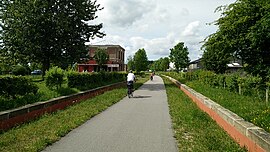Saint-Saire | |
|---|---|
 The green cycleway through the old railway station | |
| Coordinates: 49°41′41″N 1°29′37″E / 49.6947°N 1.4936°E | |
| Country | France |
| Region | Normandy |
| Department | Seine-Maritime |
| Arrondissement | Dieppe |
| Canton | Neufchâtel-en-Bray |
| Intercommunality | CC Bray-Eawy |
| Government | |
| • Mayor (2020–2026) | Maryse Duval[1] |
| Area 1 | 13.32 km2 (5.14 sq mi) |
| Population (2021)[2] | 573 |
| • Density | 43/km2 (110/sq mi) |
| Time zone | UTC+01:00 (CET) |
| • Summer (DST) | UTC+02:00 (CEST) |
| INSEE/Postal code | 76649 /76270 |
| Elevation | 88–193 m (289–633 ft) (avg. 104 m or 341 ft) |
| 1 French Land Register data, which excludes lakes, ponds, glaciers > 1 km2 (0.386 sq mi or 247 acres) and river estuaries. | |
Saint-Saire (French pronunciation: [sɛ̃ sɛʁ]) is a commune in the Seine-Maritime department in the Normandy region in north-western France.
Geography
[edit]A village of farming and associated light industry situated by the banks of the river Béthune in the Pays de Bray, some 30 miles (48 km) southeast of Dieppe at the junction of the D7, D19 and the D1314 roads.
Population
[edit]| Year | Pop. | ±% p.a. |
|---|---|---|
| 1968 | 514 | — |
| 1975 | 433 | −2.42% |
| 1982 | 374 | −2.07% |
| 1990 | 418 | +1.40% |
| 1999 | 477 | +1.48% |
| 2007 | 582 | +2.52% |
| 2012 | 635 | +1.76% |
| 2017 | 611 | −0.77% |
| Source: INSEE[3] | ||
Places of interest
[edit]- The church of St. Saire, dating from the thirteenth century.
People
[edit]- Henri de Boulainvilliers, French write and historian, was born here.
See also
[edit]References
[edit]- ^ "Répertoire national des élus: les maires". data.gouv.fr, Plateforme ouverte des données publiques françaises (in French). 2 December 2020.
- ^ "Populations légales 2021" (in French). The National Institute of Statistics and Economic Studies. 28 December 2023.
- ^ Population en historique depuis 1968, INSEE



Well, that’s interesting to know that Psilotum nudum are known as whisk ferns. Psilotum nudum is the commoner species of the two. While the P. flaccidum is a rare species and is found in the tropical islands. Both the species are usually epiphytic in habit and grow upon tree ferns. These species may also be terrestrial and grow in humus or in the crevices of the rocks.
View the detailed Guide of Psilotum nudum: Detailed Study Of Psilotum Nudum (Whisk Fern), Classification, Anatomy, Reproduction